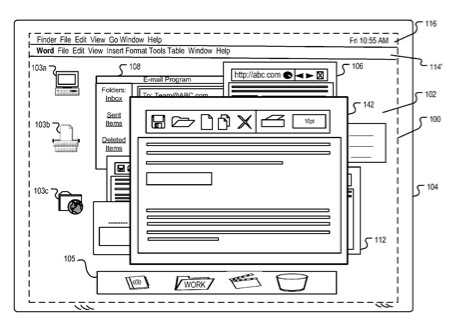Apple has applied for two patents at the U.S. Patent & Trademark Office involving windows in Mac OS X. They involve 3D-ish effects on the desktop.
Patent number 20120131496 is for methods, systems and computer-readable media for managing open windows in a desktop graphical user interface (GUI) are disclosed. In various implementations, open windows displayed within a 2D desktop plane can be organized into one or more 3D browsable stacks in a 3D desktop space, where each stack includes open windows associated with a common value for a grouping property. A graphical representation indicating the respective value of the grouping property associated with each 3D browsable stack can be displayed in proximity to the 3D browsable stack.
As the user browses through the open windows in the browsable stack, one window is displayed in a frontal view at a time while the other windows are displayed in a side view. When the user selects an open window from the stack, the 3D desktop can be restored to the 2D desktop showing the selected window as the current active window of the 2D desktop.
Patent number 20120131495 involves browsing and interacting with open windows. In various implementations, within a three-dimensional desktop, the open windows can be displayed in a three-dimensional browsable parade. As the user browses through the open windows in the browsable parade, the open window passing through a designated primary location of the three-dimensional desktop becomes the current active window of the desktop. An application menu bar of the current active window can be displayed on the three-dimensional desktop. The application menu bar and the active window together provide the full range of interactive capabilities that the native application environment of the open window would allow, even though the open window is currently displayed within the browsable parade.
Thomas Goossens and Fabrice Robinet are the inventors on both patents.
Along the same line is patent 20120127156 for presenting and browsing items in a tilted 3D space. In tilted viewing mode, groups of items from several consecutive levels of a hierarchy can be presented in respective browsable parades shown at different depths into a viewable region of the tilted 3D space. The user can browse laterally across each browsable parade, and browse up and down the hierarchy within the tilted 3D space.
With the combination of browsing laterally across the parades presented in the viewable region of the tilted 3D space and browsing up and down the hierarchy along the depth dimension of the 3D space, the user can navigate the entirety of the hierarchy in the tilted 3D space. Goossens and Laurent Baumann are the inventors.



